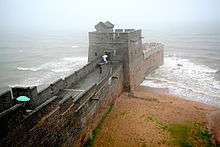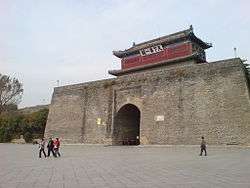Shanhai Pass
Coordinates: 40°00′33.71″N 119°45′14.92″E / 40.0093639°N 119.7541444°E
| Shanhai Pass | |||||||||||||
|
The "First Pass Under Heaven" plaque on Shanhaiguan's main gate | |||||||||||||
| Simplified Chinese | 山海关 | ||||||||||||
|---|---|---|---|---|---|---|---|---|---|---|---|---|---|
| Traditional Chinese | 山海關 | ||||||||||||
| Literal meaning | "Mountain and Sea Pass" | ||||||||||||
| |||||||||||||
Shanhai Pass, known in Chinese as Shanhaiguan (simplified Chinese: 山海关; traditional Chinese: 山海關; pinyin: Shānhǎiguān; formerly Shan-hai-kwan or Shan-hai-kuan), also called Yu Pass (simplified Chinese: 榆关; traditional Chinese: 榆關; pinyin: Yúguān), is one of the major passes in the Great Wall of China. The words "First Pass Under Heaven" (simplified Chinese: 天下第一关; traditional Chinese: 天下第一關; pinyin: Tiānxià Dìyī Guān) are engraved above one of the gates, and so the site is also known by that name. It is located in Shanhaiguan District, Qinhuangdao, Hebei province.
In 1961, the pass became a National Cultural Site of China. It is a popular tourist destination given its situation at the eastern end of the main line of the Ming Dynasty Great Wall. The location where the wall meets the Bohai Sea is nicknamed "Old Dragon's Head" (老龙头). The pass lies nearly 300 kilometres (190 mi) east of Beijing and is linked via the Jingshen Expressway that runs northeastward to Shenyang.
Throughout Chinese history, the pass served as a frontline defense against ethnic groups from Manchuria, including the Khitan, Jurchen and the Manchus.
History
Located south of Yan Mountain, and north of the Bohai Sea, for centuries the pass guarded the narrow passage between Northeast and Central East China. Both the Northern Qi Dynasty and the Tang Dynasty constructed passes here. In 1381, Ming general Xu Da constructed the present pass, which was named Shanhaiguan (literally "mountain-sea-pass") because of its position between the mountains and the sea. In the late 16th century, Ming general Qi Jiguang began fortification and construction of a military city around the pass, building cities and forts to the east, south and north, making it one of the most heavily fortified passes in China. Today it is one of the best preserved passes in the Great Wall.
Battle of Shanhai Pass
In 1644, Li Zicheng led a rebel army into the Ming dynasty capital of Beijing, marking the official end of the Ming dynasty. After occupying the capital, Li attempted to enlist the support of Ming general Wu Sangui, commander of the powerful Ningyuan garrison north of the Great Wall. Rather than submit to Li, Wu contacted the Manchu Qing dynasty, suggesting that they combine forces to drive the rebels from the capital. Dorgon, regent of the Qing, marched his army to Shanhai Pass to receive Wu's surrender. Together, Wu and the Manchus defeated Li Zicheng's army near the pass, and Li was forced to abandon the capital. The Qing victory enabled their army to enter Beijing unopposed, and established them as the dominant power in China.[1]
Later history
During the Qing era, the Shanhai Pass, situated between Shenyang and Beijing, was referred to as the "Key to the Capitals". During the Republican era, as well as during the Eight-Nation Alliance and World War II, the pass witnessed many conflicts.
The 1911 Encyclopaedia Britannica noted:
SHANHAI-KWAN, a garrison town in the extreme east of the province of Chih-li, China. Pop. about 30,000. It is situated at the point where the range of hills carrying the Great Wall of China dips to the sea, leaving a kwon or pass of limited extent between China proper and Manchuria. It is thus an important military station, and the thoroughfare of trade between Manchuria and the great plain of China. The Imperial Northern railway from Tientsin and Taku, 174 m. from the former, runs through the pass, and skirts the shore of the Gulf of Liao-tung as far as the treaty port of Niu-chwang, where it connects with the railways leading from Port Arthur to the Siberian main line. The pass formed the southern limit of the Russian sphere of influence as defined in the convention between Great Britain and Russia of the 28th of April 1899.
In July 1900, 15,000 Japanese troops landed at Shanhai Pass, prior to marching on Peking to relieve the siege of the legations by the Boxers. A pre-landing bombardment of the area was unnecessary as few Chinese troops were present.[2] Inter-allied relations were dealt a blow when a drunken fracas occurred at the Shanhai Pass between Japanese and French troops. In the fighting three French and seven Japanese soldiers were killed, and five French and 12 Japanese were wounded.[3]
In November 1945, the North Eastern People's Liberation Army (PLA) attempted to hold Shanhaiguan against Guomindang forces attacking from the south. They sought to keep Chiang Kai-shek out of Manchuria. The PLA forces of 10,000 were under equipped and too few to defend the position and retreated to Siping.
Structure

The Shanhai Pass is built as a square, with a perimeter of around 4 kilometres (2.5 mi). The walls reach a height of 14 metres (46 ft), and are 7 metres (23 ft) thick. The east, south and north sides are surrounded by a deep, wide moat with drawbridges over it. In the middle of the pass stands a tall bell tower.
All four sides of the Shanhai Pass once possessed a gate or mén (门), with the Zhèndōng Gate (镇东门) in the east wall, the Yíng'ēn Gate (迎恩门) in the west, the Wàngyáng Gate (望洋门) in the south and the Wēiyuǎn Gate (威远门) in the north. Due to lack of repairs over the centuries, only the Zhèndōng Gate remains today. This was the most important gate due to its position, which faces outside the pass towards Beijing.
See also
References
- ↑ Wakeman 1985, pp. 290–318
- ↑ Straits Times, 18 July 1900, p.2
- ↑ Sydney Morning Herald, 19 July 1904 p.5
- Wakeman, Frederic (1985), The Great Enterprise: The Manchu Reconstruction of Imperial Order in Seventeenth-century China, Berkeley: University of California Press, ISBN 0520048040
External links
| Wikimedia Commons has media related to Shanhaiguan. |
 Shanhaiguan travel guide from Wikivoyage
Shanhaiguan travel guide from Wikivoyage- Photos of Shanhaiguan
- Great Wall of China Man made Object
- Illustrated Atlas of Shanhai, Yongping, Jizhou, Miyun, Gubeikou, Huanghua Zhen and Other Areas
